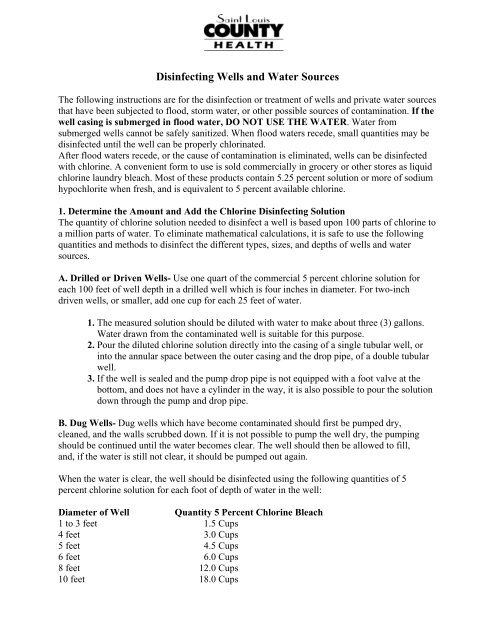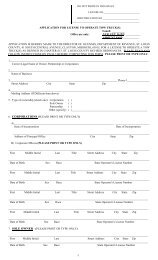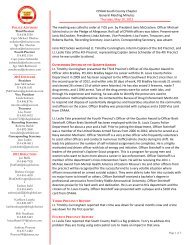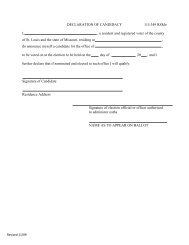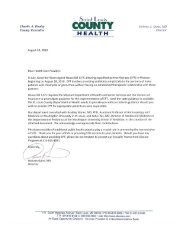Disinfecting Wells and Water Sources - St. Louis County
Disinfecting Wells and Water Sources - St. Louis County
Disinfecting Wells and Water Sources - St. Louis County
- No tags were found...
You also want an ePaper? Increase the reach of your titles
YUMPU automatically turns print PDFs into web optimized ePapers that Google loves.
<strong>Disinfecting</strong> <strong>Wells</strong> <strong>and</strong> <strong>Water</strong> <strong>Sources</strong>The following instructions are for the disinfection or treatment of wells <strong>and</strong> private water sourcesthat have been subjected to flood, storm water, or other possible sources of contamination. If thewell casing is submerged in flood water, DO NOT USE THE WATER. <strong>Water</strong> fromsubmerged wells cannot be safely sanitized. When flood waters recede, small quantities may bedisinfected until the well can be properly chlorinated.After flood waters recede, or the cause of contamination is eliminated, wells can be disinfectedwith chlorine. A convenient form to use is sold commercially in grocery or other stores as liquidchlorine laundry bleach. Most of these products contain 5.25 percent solution or more of sodiumhypochlorite when fresh, <strong>and</strong> is equivalent to 5 percent available chlorine.1. Determine the Amount <strong>and</strong> Add the Chlorine <strong>Disinfecting</strong> SolutionThe quantity of chlorine solution needed to disinfect a well is based upon 100 parts of chlorine toa million parts of water. To eliminate mathematical calculations, it is safe to use the followingquantities <strong>and</strong> methods to disinfect the different types, sizes, <strong>and</strong> depths of wells <strong>and</strong> watersources.A. Drilled or Driven <strong>Wells</strong>- Use one quart of the commercial 5 percent chlorine solution foreach 100 feet of well depth in a drilled well which is four inches in diameter. For two-inchdriven wells, or smaller, add one cup for each 25 feet of water.1. The measured solution should be diluted with water to make about three (3) gallons.<strong>Water</strong> drawn from the contaminated well is suitable for this purpose.2. Pour the diluted chlorine solution directly into the casing of a single tubular well, orinto the annular space between the outer casing <strong>and</strong> the drop pipe, of a double tubularwell.3. If the well is sealed <strong>and</strong> the pump drop pipe is not equipped with a foot valve at thebottom, <strong>and</strong> does not have a cylinder in the way, it is also possible to pour the solutiondown through the pump <strong>and</strong> drop pipe.B. Dug <strong>Wells</strong>- Dug wells which have become contaminated should first be pumped dry,cleaned, <strong>and</strong> the walls scrubbed down. If it is not possible to pump the well dry, the pumpingshould be continued until the water becomes clear. The well should then be allowed to fill,<strong>and</strong>, if the water is still not clear, it should be pumped out again.When the water is clear, the well should be disinfected using the following quantities of 5percent chlorine solution for each foot of depth of water in the well:Diameter of Well Quantity 5 Percent Chlorine Bleach1 to 3 feet 1.5 Cups4 feet 3.0 Cups5 feet 4.5 Cups6 feet 6.0 Cups8 feet 12.0 Cups10 feet 18.0 Cups
Add this quantity of chlorine bleach directly into the well interior.C. Cisterns- Cisterns, spring collection basins, or drinking water storage tanks should bedisinfected in the same manner as dug wells. Pump out, or drain the water in the cistern;scrub down the interior walls; fill or allow the tank to refill with clear water; <strong>and</strong>, if it is notknown, calculate the capacity of the tank or containment by using one of the followingformulas:a. Square or Rectangular Tank measure in feet:Capacity (gallons) = Length x Width x Depth x 7.5b. Cylindrical Tank measure in feet:Capacity (gallons) = Diameter x Diameter x Length x 5.9c. Add the amount of 5 percent chlorine solution indicated in the following table:Capacity (Gallons)Quantity of 5 Percent Chlorine Bleach500 5.0 Quarts750 7.5 Quarts1,000 10 Quarts2,000 20 Quarts4,000 40 QuartsThis amount of chlorine bleach should be poured directly into the cistern or storage tank.2. Allow Time for Disinfection of the <strong>Water</strong> Source <strong>and</strong> Distribution SystemAfter the well, cistern, or storage tank has been dosed with the appropriate amount of chlorine, itshould be pumped just long enough to bring the treated water through the pump to all faucets onthe distribution system. The odor at the faucets will be a good test to indicate chlorine presence.If the above dosages do not produce an obvious chlorine odor in the water, add more chlorinebleach solution until a distinct odor is noticed.Let the chlorinated well <strong>and</strong> distribution system st<strong>and</strong> for 12 to 24 hours. This will allow time forthe chlorine solution to disinfect the well, or water source, <strong>and</strong> distribution system. After at least12 hours, the system should be pumped to waste until no further trace of chlorine isnoticeable in the water.If you have public or municipal sewers, run each tap until the disinfectant odor disappears, whileallowing the water to go down the fixture drain. If you have a septic system, it is preferable tofirst connect a garden hose to an outside faucet or hydrant <strong>and</strong> run the water into a roadside ditchor drainage swale, until the disinfectant odor disappears. Then, turn on each water faucet todischarge the chlorine residual in the immediate vicinity of the faucet.3. Sample the <strong>Water</strong> for Bacteriological Analysis Before UseFollowing disinfection of the water supply system, the water should be sampled forbacteriological analysis. Remember that no water should be used for drinking or foodpreparation, unless it is first boiled or treated, until a satisfactory report is obtained from alaboratory. The safety of water cannot be judged by color, odor, or taste. The organisms thatcause water-borne disease cannot be seen.Source: University of Missouri Extension, Disaster Resources H<strong>and</strong>book, 2004


